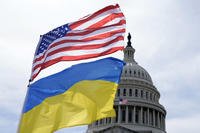Iraq's elite U.S-trained Counter-Terrorism Service (CTS) units need more live-fire training on weapons such as the shoulder-fired, recoilless AT4 launchers that have proven effective in stopping ISIS car bombs, the Defense Department's Inspector General office said in a report last week.
The 42-page report issued last Friday said the lack of training for CTS recruits with the AT4 and other anti-armor weapons could have serious consequences in combat for the CTS, widely considered the most effective unit in the Iraqi Security Forces (ISF). The report said that the same logistics problems in getting equipment for training out of warehouses is also affecting ISF special operations forces.
The IG's report "concluded that the Iraqi CTS soldiers may not be fully prepared to employ the AT4, M72, and SPG-9 weapons in combat. That could make them less effective, putting the success of combat engagements at risk. Lack of live-fire training could also increase the risk of friendly casualties from back blast, as well as other collateral damage to nearby facilities and equipment."The AT4 is a single-shot, 84mm recoilless weapon. The Vietnam-era M-72 Light Anti-Armor Weapon is a single-shot, 66mm, shoulder-fired weapon. The Russian-made SPG-9 is a tripod-mounted, 73mm recoilless gun that fires rocket-assisted munitions.
All three have been used by the ISF against fighting positions of the Islamic State of Iraq and Syria and especially to defeat ISIS Vehicle-Borne Improvised Explosive Devices (VBIEDs).
Despite being greatly outnumbered, ISIS used VBIEDs extensively to inflict a humiliating defeat on the ISF in taking Ramadi in May 2015, resulting in the U.S. rushing shipments of AT4s to the front.
In retaking Ramadi in December 2015, the ISF used AT4s and other weapons to beat back a major ISIS counter-attack using VBIEDs on a bridgehead leading to the city, according to Combined Joint Task Force-Operation Inherent Resolve.
The IG's report included a cautionary note on how the CTS, which led the assault to retake Ramadi and other cities and now is heavily engaged in retaking Mosul, has been employed in recent months.
Following the retaking of Ramadi, "CTS units successfully led operations to liberate Hit, Fallujah, and Qayyarah. Beginning in October 2016, the CTS has also participated in the ongoing offensive operations to free Mosul," the IG's report said.
The CTS was formed as an elite unit to conduct special operations missions apart from the political infighting that has plagued other units of the ISF. The CTS reports directly to Iraqi Prime Minister Haider al-Abadi rather than going through the Iraqi Defense Ministry and Interior Ministry.
However, the CTS has repeatedly been used as the lead element for conventional forces, the IG's report said.
"The CTS continues to produce battlefield victories," the report said, but "the light infantry, combined arms, and urban combat missions (all of which the CTS now conducts in the counter ISIS-campaign) are outside the scope of its intended purpose."
The CTS originally conducted operations at the company level and below as a counter-terrorism special operations force.
"Now it is engaged at the battalion level and above, conducting conventional combined arms operations, requiring the integration of artillery, close-air support, and close coordination with other ISF units," the IG's report said.









